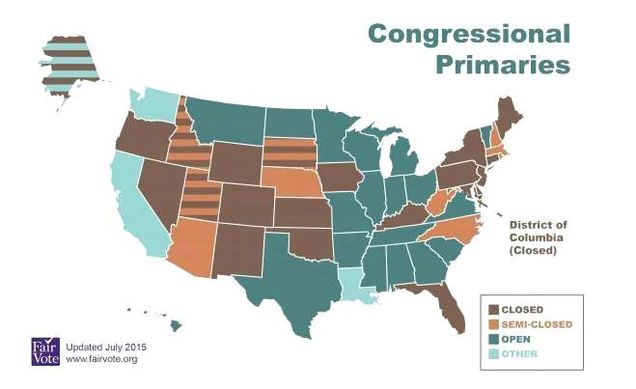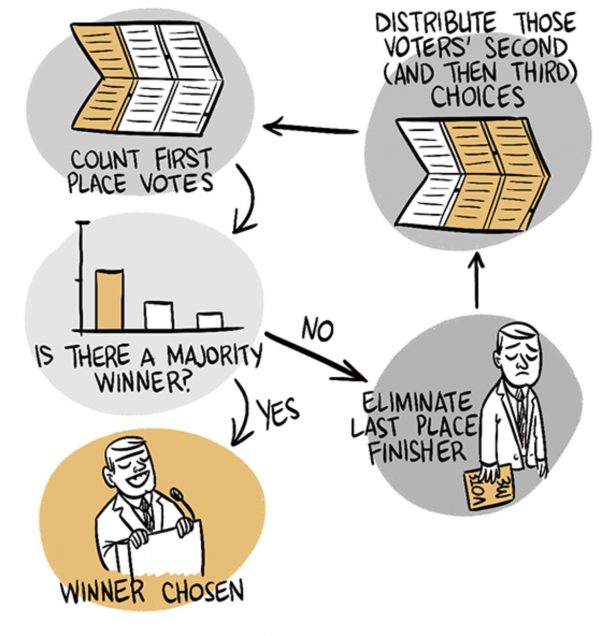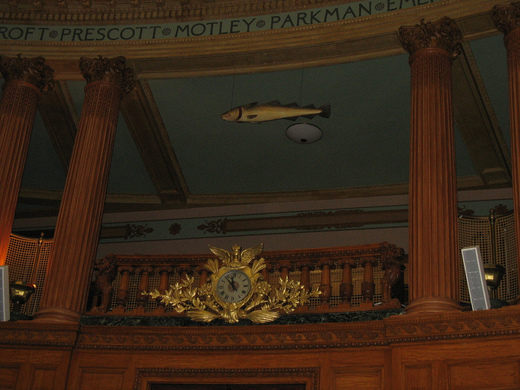Tagged: Maine
Blanket Primaries or Ranked-Choice? Why Not Both?
A substantial number of Americans continue to voice dissatisfaction with current American electoral practices. This has put Justice Brandeis’s laboratories of democracy to work by prompting some states to exercise their powers to design election systems to experiment with various electoral reforms. Those powers derive from the state constitutions for elections of state officers; Article I, Section 4 of the U.S. Constitution to “[prescribe] the Manner of holding Elections for Senators and Representatives”, and the U.S. Constitution Article II, Section 1 to determine how electors for President may be chosen.
Many states have allowed their municipalities to experiment, with a few states adopting reforms on a state-wide level. In the latter category, some states, like California and Washington, have adopted what is sometimes described as the top-two, blanket, or Louisiana primary, while Maine has implemented ranked-choice voting. While these reforms have been innovative, study of their effects reveals limited success in achieving advocates’ promises. This post concludes that by combining both reforms, states will be better positioned to access the positive outcomes hoped for.
Blanket Primaries
Former Republican congressman from Oklahoma, Mickey Edwards, has argued that the problem with American politics is our  broken election system that rewards partisanship at the expense of good policy. Edwards argues that the culprit is the primary. Primary election turnout is notoriously low, with a recent Pew Research Center study celebrating a surge in participation in the 2018 House primary elections of 56% – a surge that still left turnout in that primary under 20%. The belief is that since political participation in primaries is so low, they are dominated by the most active, and most partisan, members of the parties, limiting the success of more centrist candidates, who are presumably more representative of their districts. In particularly politically active years, incumbents are at risk of being “primaried” by extremists in their party. Thus, the candidates in the general election tend to be more extreme, on both ends, than the district, and the eventual winner is then likely to represent only one extreme, rather than the district as a whole.
broken election system that rewards partisanship at the expense of good policy. Edwards argues that the culprit is the primary. Primary election turnout is notoriously low, with a recent Pew Research Center study celebrating a surge in participation in the 2018 House primary elections of 56% – a surge that still left turnout in that primary under 20%. The belief is that since political participation in primaries is so low, they are dominated by the most active, and most partisan, members of the parties, limiting the success of more centrist candidates, who are presumably more representative of their districts. In particularly politically active years, incumbents are at risk of being “primaried” by extremists in their party. Thus, the candidates in the general election tend to be more extreme, on both ends, than the district, and the eventual winner is then likely to represent only one extreme, rather than the district as a whole.
To address this concern, Edwards advocates for a reform known as “blanket” primaries, sometimes referred to as “Louisiana,” “jungle,” or, most accurately, “top two” primaries. This reform provides that in the primary election, there is a single ballot, with all candidates on the ballot regardless of party. The top-two candidates who receive the most votes then move on to the general election. This means that the candidates in the general election may both be from the same party, particularly in districts whose residents heavily identify with one party over the other. This may make for more competitive general elections, in that a candidate who is almost certain not to win isn’t on the ballot, in favor of a candidate who actually has a chance of convincing voters to vote for them. Also, along with Edwards’s hope that this will reduce partisanship by ensuring the candidates in the general election better represent the center of the district, advocates have also claimed that it will increase turnout.
Unfortunately, the data provides only marginal support for the proposition that blanket primaries reduce partisanship and increase turnout. An added challenge to blanket primaries is that because only the top-two move on, it is subject to vote splitting – if too many candidates from a party enter the race, they may end up without any candidates in the general simply by virtue of the number of candidates in the race, rather than voter preferences. Thus, blanket primaries are not a panacea, at least on their own, for electing more representative representatives.
Ranked-Choice Voting
Maine has moved in a different direction, adopting ranked-choice voting (“RCV”), a darling of electoral reform advocates for decades. RCV has a long pedigree, first having been promoted publicly in the United States by William Robert Ware in the 1870s. Some states and municipalities flirted with a version of RCV, known as single transferable vote, in the last great shift in party power during the early- to mid-twentieth century. RCV and similar systems have also been successfully used internationally – including in Australia, and Ireland.
While there are many different iterations of ranked-choice voting, Maine has adopted the most typical approach. There, voters may rank candidates first, second, third, and so on. If a candidate gets a majority of first-rank votes, they are declared the winner. However, if no candidate receives a majority of votes, then the candidate with the least number of votes is eliminated, and the voters who ranked that candidate first have their votes redistributed to their second-rank candidates. If no candidate has a majority, the new candidate with the lowest number of votes is eliminated, and their voters’ ballots are also redistributed. The system continues until a candidate has secured a majority of preferences.
Advocates of ranked-choice have also claimed that the system reduces partisanship, since candidates are encouraged to appeal to voters to rank them second, even if they can’t secure their first preference. Advocates also argue that it increases turnout by
making the ballot more reflective of voters’ wishes. As with blanket primaries, however, there is only modest statistical data showing that the turnout hopes are borne out.
A Proposal
States should consider merging the two systems, blanket primaries and RCV, in order to best access the benefits of each. The real problem that neither system effectively can address is the issue of turnout. Primary elections typically draw the most politically aware sector of the electorate that is most invested in who the candidates in the general election are, but turnout remains exceedingly low regardless of the system. Blanket primaries attempt to appeal to an electorate disenchanted by the current partisan model and looking to elect “the best candidate,” but since they continue to rely on a two-stage electoral model, they don’t resolve the fundamental problem. The most partisan members of the electorate participate in the blanket primary, and turnout surges, as it always does, in the general, after the partisans have already selected who will be on the ticket. Combining ranked-choice with the blanket primary would allow there to be a single election, ensuring the highest number of voters considering all the available candidates, not just those the partisans have already selected. Moving to a single election, with candidates on a single ballot regardless of party, and using RCV would ensure that the larger electorate would be able to weigh-in, allow them to rank their preferences, and ensure that the candidate who emerged was the preferred candidate of a majority of voters. This will increase elected officials’ mandate, and provide more information about what direction the district would like to go in.
Stop the Clock: Implications of Switching Time Zones
The holiday season is joyous for many reasons; from family, friends, and food, there is ample joy and merriment to go around. There is one aspect of the season that doesn’t match these factors; especially in New England – darkness. At the outset of winter, on December 21st each year, the sun sets in Boston at 4:11pm. There are many negative effects of darkness setting in before the end of the workday – with increased crime, traffic accidents, and seasonal depression being one of the most paramount. Boston’s sunset is not the earliest in the area, with municipalities in Maine experiencing sunsets earlier than 4pm; but it is the earliest of the major cities, beating out Buffalo, NY despite being further south.
Early sunsets do not become apparent in New England until clocks fall back in line with the change from Daylight Savings Time. Daylight Savings is a federal program instituted during World War II that the country has become accustomed to; the federal legislation only permits states to opt out of the program, but it does not allow states to make the program permanent, which would keep the clocks from falling back an hour. Hawaii and Arizona have opted out of the program – made available through the US Energy Policy Act of 2005, allowing any state that lies entirely within one time zone to opt out.
New England states, primarily Massachusetts and Maine at this point, have been considering a change to the Atlantic Time Zone
in order to increase the number of waking hours with sunlight. With a change to Atlantic Time, and subsequent opting out daylight savings, New England would be out of sync with the rest of the Eastern Time Zone from November to March, or the period in which clocks “fall back” in line with daylight savings in the Eastern Time Zone. A transfer to Atlantic Standard Time – which includes Puerto Rico, the Virgin Islands and eastern Canada – would mean jumping an hour ahead of the Eastern time zone from November to February. The time zones would align from March to October.
While the benefits of having an extended amount of light in the evening hours are readily apparent, there are several drawbacks that accompany a change. Early risers in particular, who are likely accustomed to the sun being out while they start their days have reason to complain. School aged children may be leaving to their schools in darkness in the morning, and businesses that transact on financial markets may be put out of sync with the markets they depend on.
If New England were to change to Atlantic time, there would be a two-step process. First, the interested states would have to decide to leave. Second, the states would have to consult the US Department of Transportation, the cabinet agency that regulates time zones. States, municipalities, business interests, and others would have the opportunity to weigh in during both steps.
 There could be major issues with “commerce, trade, interstate transportation and broadcasting” if one state moves ahead one hour while its neighboring states remain in the Eastern Time Zone. It seems to be a requirement of widespread support and agreement for any change in this area to take effect. Lawmakers in Maine might support the change – in May 2017, Maine’s Senate passed a bill that would move the state to the Atlantic Time Zone — if approved by residents in a state-wide referendum. Maine conditioned the change, subject to their approval, on Massachusetts and New Hampshire.
There could be major issues with “commerce, trade, interstate transportation and broadcasting” if one state moves ahead one hour while its neighboring states remain in the Eastern Time Zone. It seems to be a requirement of widespread support and agreement for any change in this area to take effect. Lawmakers in Maine might support the change – in May 2017, Maine’s Senate passed a bill that would move the state to the Atlantic Time Zone — if approved by residents in a state-wide referendum. Maine conditioned the change, subject to their approval, on Massachusetts and New Hampshire.
Some states seem to have considered the idea and decided against it, with the New Hampshire Senate voting against a bill that would move the state to the Atlantic Time Zone by a 16 to 7 vote; at the same time, the bill passed the house with a voice vote. While there has yet to be an affirmative move, the proponents of the change are enlivened by the action around the issue and are hopeful for the future.
Massachusetts established a commission to study the issue. In a neutral report neither supporting or disavowing the change, the commission stated its findings that "People tend to shop, dine out, and engage in other commercial activities more in after-work daylight,". . . "Year-round DST could also increase the state's (competitiveness) in attracting and retaining a talented workforce by mitigating the negative effects of Massachusetts' dark winters and improving quality-of-life." More daylight could also reduce street crime, on-the-job injuries and traffic fatalities, and boost overall public health, the commission found.
States in the Northeast seem intrigued by the change, but alterations of the particulars of their citizen’s days are deeply personal to their citizens may be a drastic change to take without widespread public support. In Arizona, the effects of their non-adherence to daylights savings time are apparent when the state is out of sync with the rest of the surrounding states – constant clarification of what time is in effect, setting different meeting times, etc. Results on an individual basis are a mixed bag, with businesses that are purely local and that thrive in the daylight being supporters of the longer day due to increased business, and those who constantly run up against timing differences by virtue of dealing with other regions.
It will be interesting to observe if public support for a time zone change increases as people in New England become aware that doing so is a possibility to increase their daylight hours in the depths of winter. In any case, it is clear that the states’ legislatures have identified it as a possible issue.
 Drew Kohlmeier is a student in the Boston University School of Law Class of 2020 and is a native of Manhattan, KS, graduating with a degree in Biology from Kansas State University in 2016. Drew decided on Boston for law school due to his interest in health care and life sciences, and will be practicing in the emerging companies space focused on the life sciences industry following his graduation from BU.
Drew Kohlmeier is a student in the Boston University School of Law Class of 2020 and is a native of Manhattan, KS, graduating with a degree in Biology from Kansas State University in 2016. Drew decided on Boston for law school due to his interest in health care and life sciences, and will be practicing in the emerging companies space focused on the life sciences industry following his graduation from BU.





